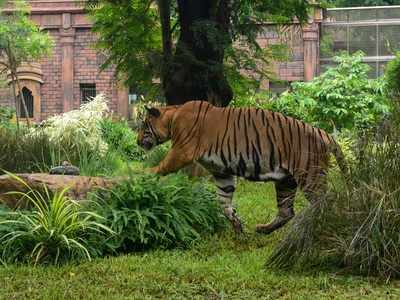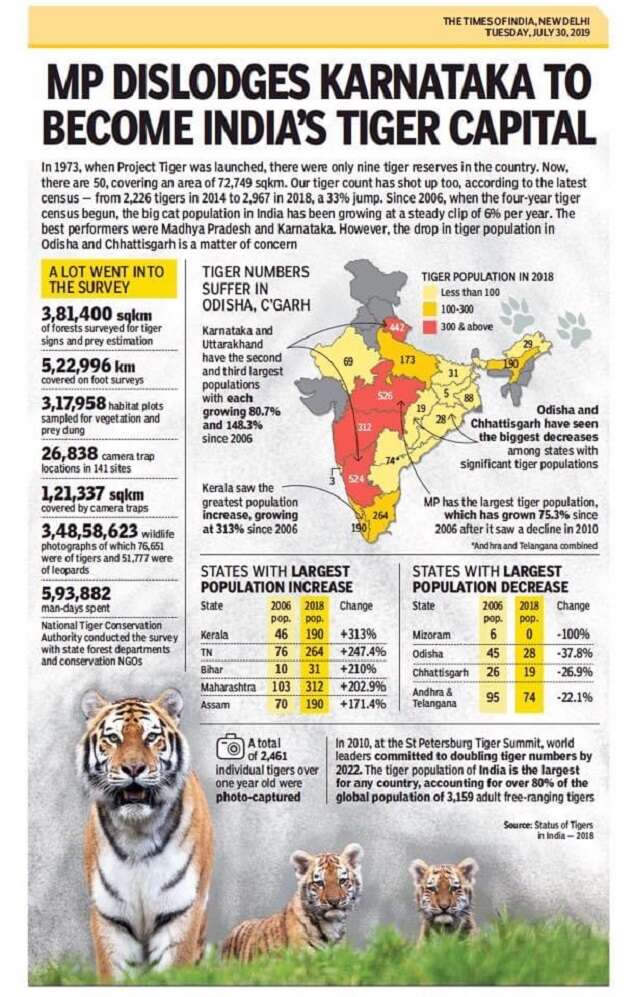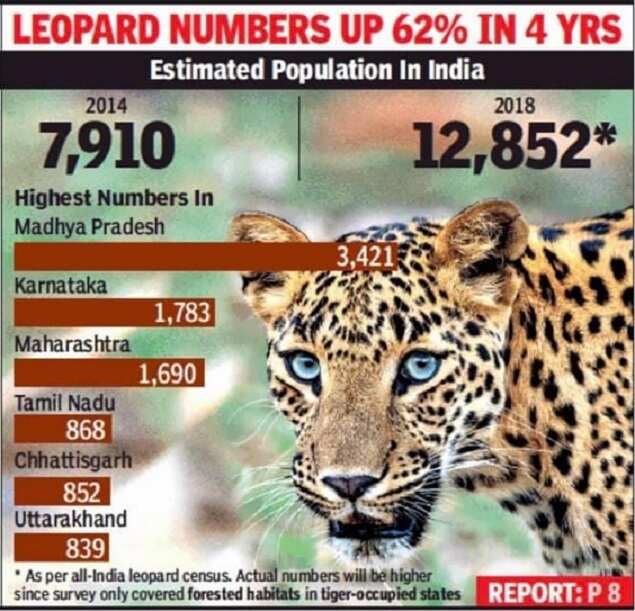Top Searches
- News
- India News
- International Tiger Day: 14 tiger reserves of India get elite tag of conservation
International Tiger Day: 14 tiger reserves of India get elite tag of conservation

Royal Bengal tiger “Shakti” plays inside the tiger enclosure at Mumbai Zoo on International Tiger Day on Thursday at Byculla -Prashant Jadhav, July 29, 2021.
NEW DELHI: 14 tiger reserves of India, including three each in Assam and Madhya Pradesh, have got the Conservation Assured | Tiger Standards (CA|TS) accreditation, which is a globally accepted conservation tool that sets best practice and standards to manage tigers, the environment ministry announced on International Tiger Day on Thursday.
The three most popular tiger reserves in terms of tourists’ footfalls - Corbett (Uttarakhand), Ranthambore (Rajasthan) and Bandhavgarh (Madhya Pradesh) – however do not figure in the list of 14.

Drawing attention to this “surprising” fact during a function to share details of the elite tag of tiger conservation areas, environment secretary R P Gupta said, “When I saw the list, I found that the 14 areas (reserves) are such where tourists’ presence is not that much. So, it’s very vital that we just don’t make these tiger reserves a tourist destination as our topmost priority.”
The 14 reserves which figured in the list include Manas, Kaziranga and Orang in Assam; Sundarbans in West Bengal; Valmiki in Bihar; Dudhwa in Uttar Pradesh; Panna, Kanha and Satpura in Madhya; Pradesh; Pench in Maharashtra; Anamalai and Mudumalai in Tamil Nadu; Parambikulam in Kerala; and Bandipur, Karnataka.
Prime Minister Narendra Modi while tweeting on the international tiger day reiterated India's commitment to ensuring safe habitats for tigers and nurturing tiger-friendly eco-systems. “India’s strategy of tiger conservation attaches topmost importance to involving local communities. We are also inspired by our centuries old ethos of living in harmony with all flora and fauna with whom we share our great planet,” tweeted Modi.
PM also flagged that the last tiger census of 2018 showed a rise in the tiger population and the country achieved the target of doubling of tiger population four years ahead of schedule of the St Petersburg declaration on tiger Conservation.
As per the last census (2018), India has 2,967 tigers and 12,852 leopards. While the population of tigers recorded an increase of 33% since the last census (2014), leopard numbers recorded a jump of 62% since 2014.

Underlining census data on leopards that was released in December last year, environment minister Bhupender Yadav on the occasion said the increase in number of leopards “reaffirms the fact that conservation of tigers helps in the conservation of the entire ecosystem … Tiger conservation is a symbol of saving the entire ecosystem including flora and fauna”.
He also emphasized on the need to take care of sensitivity of the local population and asked officials to take them on board for conservation efforts.
Besides 14 in India, only three other sites – one each in Nepal, Bhutan and Russia – have got the CA|TS tag which is being given through a prescribed process of site registration through external evaluation including verification of evidence.
Globally, the CA|TS is being implemented across 125 sites in seven tiger range countries. 94 of them are in India. Besides the 14 tiger reserves which have got the elite tag in India, the process in three more Reserves are completed.
“CA|TS accreditation is a global recognition of good tiger governance. This recognition means a lot in the context of adaptation to climate change, sustainability of ecosystem services, and safeguarding disruption of zoonotic cycles, through an umbrella species approach,” said Rajesh Gopal, secretary general, Global Tiger Forum (GTF).
The GTF and WWF India are implementing partners of the National Tiger Conservation Authority for CA|TS assessment in the country. “This is the first time that site assessments were carried out using CA|TS-LOG, the software that helps in visualizing data and tracking site-based tiger conservation. India is the first country to roll this out nationally,” said the WWF India in a statement on the process.
It claimed that all the 14 accredited sites in India met “Standard Exceeded” or “Standard Achieved” in case of majority of the 17eElements under the seven CA|TS pillars - importance and status, management, community, tourism, protection, habitat management and tiger populations - thereby reaching overall CA|TS scores of above 70% which is the minimum requirement for consideration for accreditation.
“The CA|TS accreditation to 14 tiger reserves in India signifies that these Reserves have achieved excellence in tiger site management. This accreditation will strengthen management practices in the sites as per international common criteria,” Ravi Singh, secretary general & CEO, WWF India.
The three most popular tiger reserves in terms of tourists’ footfalls - Corbett (Uttarakhand), Ranthambore (Rajasthan) and Bandhavgarh (Madhya Pradesh) – however do not figure in the list of 14.

Drawing attention to this “surprising” fact during a function to share details of the elite tag of tiger conservation areas, environment secretary R P Gupta said, “When I saw the list, I found that the 14 areas (reserves) are such where tourists’ presence is not that much. So, it’s very vital that we just don’t make these tiger reserves a tourist destination as our topmost priority.”
The 14 reserves which figured in the list include Manas, Kaziranga and Orang in Assam; Sundarbans in West Bengal; Valmiki in Bihar; Dudhwa in Uttar Pradesh; Panna, Kanha and Satpura in Madhya; Pradesh; Pench in Maharashtra; Anamalai and Mudumalai in Tamil Nadu; Parambikulam in Kerala; and Bandipur, Karnataka.
Prime Minister Narendra Modi while tweeting on the international tiger day reiterated India's commitment to ensuring safe habitats for tigers and nurturing tiger-friendly eco-systems. “India’s strategy of tiger conservation attaches topmost importance to involving local communities. We are also inspired by our centuries old ethos of living in harmony with all flora and fauna with whom we share our great planet,” tweeted Modi.
On #InternationalTigerDay, greetings to wildlife lovers, especially those who are passionate about tiger conservati… https://t.co/j0sFhpScII
— Narendra Modi (@narendramodi) 1627531697000PM also flagged that the last tiger census of 2018 showed a rise in the tiger population and the country achieved the target of doubling of tiger population four years ahead of schedule of the St Petersburg declaration on tiger Conservation.
As per the last census (2018), India has 2,967 tigers and 12,852 leopards. While the population of tigers recorded an increase of 33% since the last census (2014), leopard numbers recorded a jump of 62% since 2014.

Underlining census data on leopards that was released in December last year, environment minister Bhupender Yadav on the occasion said the increase in number of leopards “reaffirms the fact that conservation of tigers helps in the conservation of the entire ecosystem … Tiger conservation is a symbol of saving the entire ecosystem including flora and fauna”.
He also emphasized on the need to take care of sensitivity of the local population and asked officials to take them on board for conservation efforts.
Besides 14 in India, only three other sites – one each in Nepal, Bhutan and Russia – have got the CA|TS tag which is being given through a prescribed process of site registration through external evaluation including verification of evidence.
Globally, the CA|TS is being implemented across 125 sites in seven tiger range countries. 94 of them are in India. Besides the 14 tiger reserves which have got the elite tag in India, the process in three more Reserves are completed.
“CA|TS accreditation is a global recognition of good tiger governance. This recognition means a lot in the context of adaptation to climate change, sustainability of ecosystem services, and safeguarding disruption of zoonotic cycles, through an umbrella species approach,” said Rajesh Gopal, secretary general, Global Tiger Forum (GTF).
The GTF and WWF India are implementing partners of the National Tiger Conservation Authority for CA|TS assessment in the country. “This is the first time that site assessments were carried out using CA|TS-LOG, the software that helps in visualizing data and tracking site-based tiger conservation. India is the first country to roll this out nationally,” said the WWF India in a statement on the process.
It claimed that all the 14 accredited sites in India met “Standard Exceeded” or “Standard Achieved” in case of majority of the 17eElements under the seven CA|TS pillars - importance and status, management, community, tourism, protection, habitat management and tiger populations - thereby reaching overall CA|TS scores of above 70% which is the minimum requirement for consideration for accreditation.
“The CA|TS accreditation to 14 tiger reserves in India signifies that these Reserves have achieved excellence in tiger site management. This accreditation will strengthen management practices in the sites as per international common criteria,” Ravi Singh, secretary general & CEO, WWF India.
FacebookTwitterLinkedinEMail
Start a Conversation
end of article
Quick Links
Coronavirus in MumbaiFarm bill 2020Farmers protestCoronavirus in DelhiCoronavirus in BangaloreCoronavirus symptomsCoronavirus in IndiaWest Bengal elections 2021Coronavirus NewsSolar EclipseNPRWhat is NRCCAB BillCAB and NRCAssam election 2021Podcast newsLok SabhaTamil Nadu Election 2021CongressBJP newsKerala Elections 2021Indian ArmyISRO newsSupreme Court

